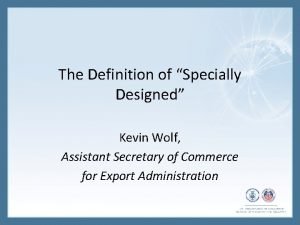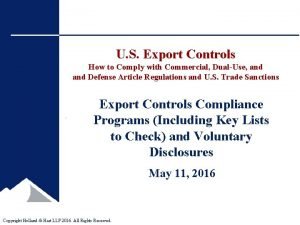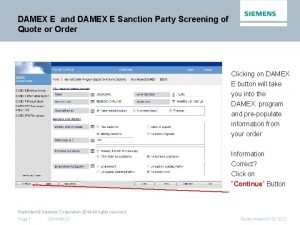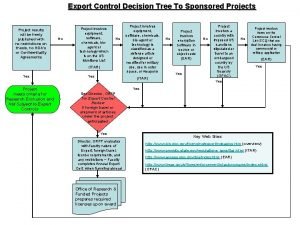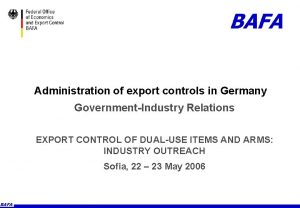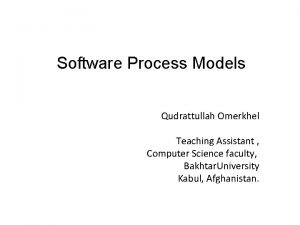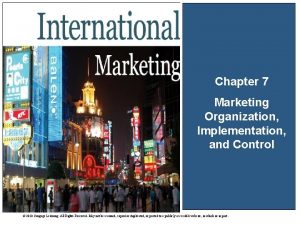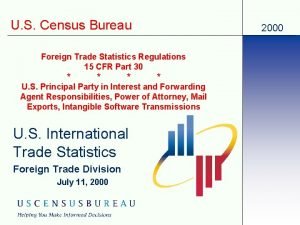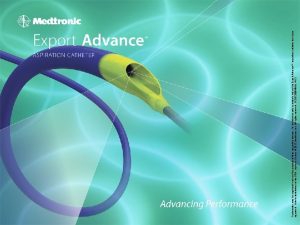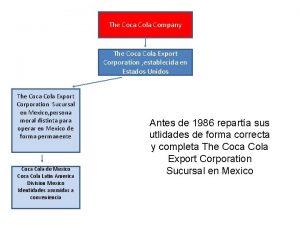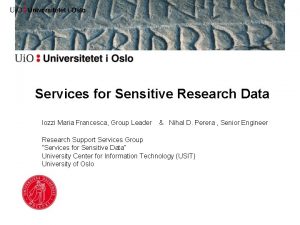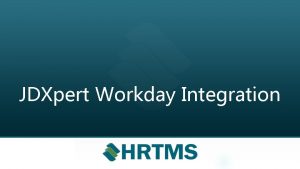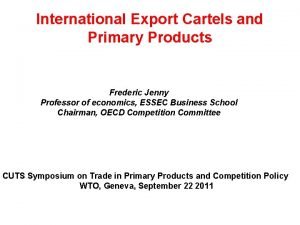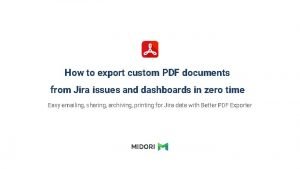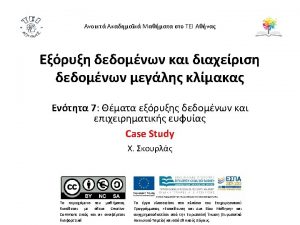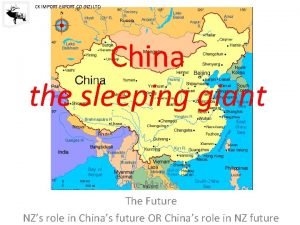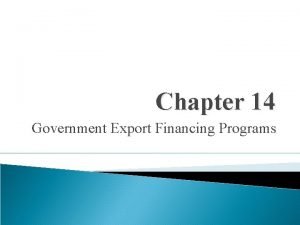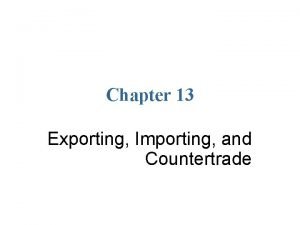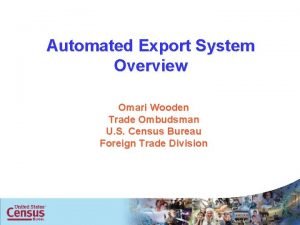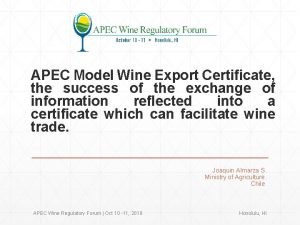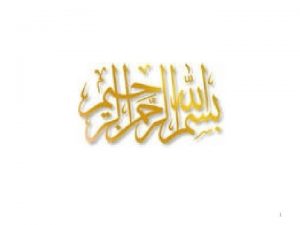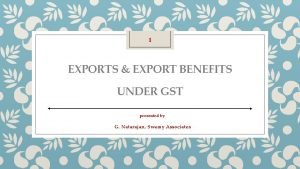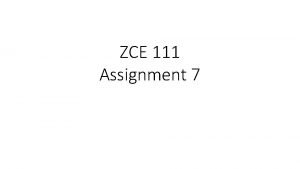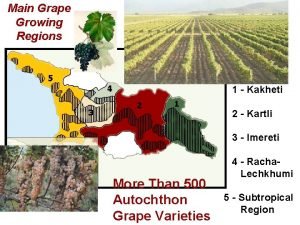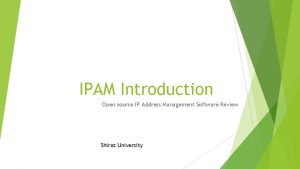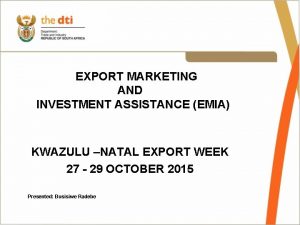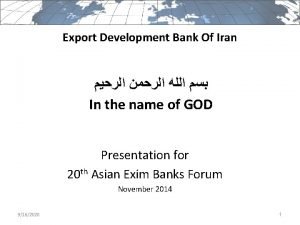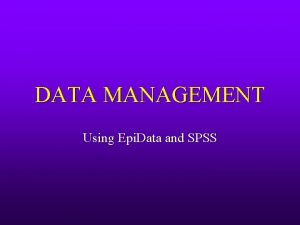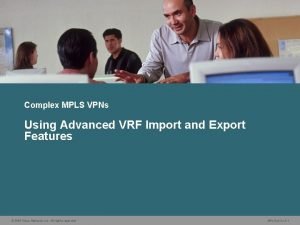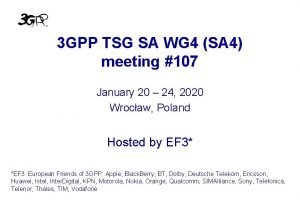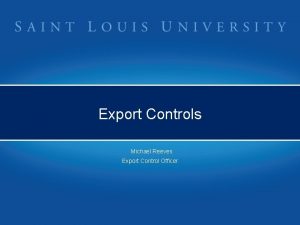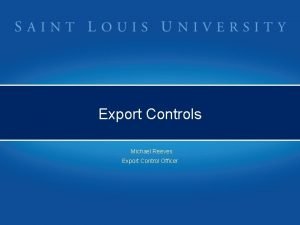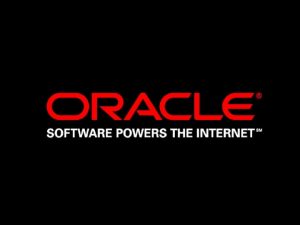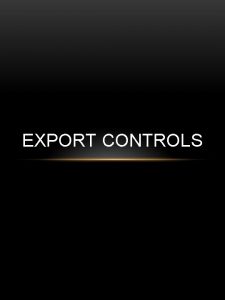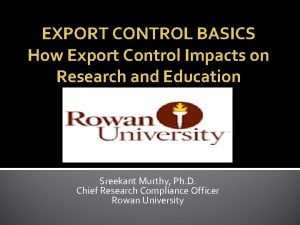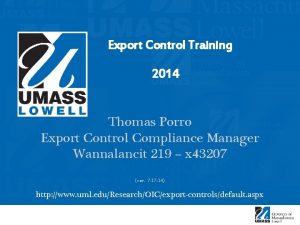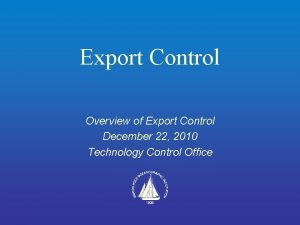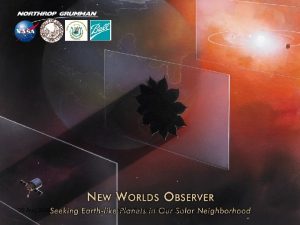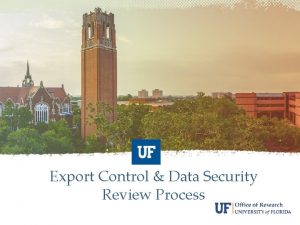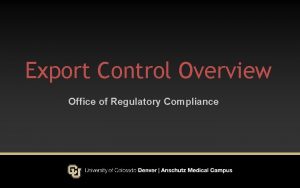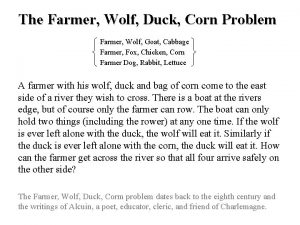Implementation of Export Control Reform Kevin Wolf Assistant







































- Slides: 39

Implementation of Export Control Reform Kevin Wolf Assistant Secretary of Commerce for Export Administration Note: This presentation is merely a summary of official statements and final rules published by the Departments of Commerce and State. Final rules, as well as the Export Administration Regulations and International Traffic in Arms Regulations, must be reviewed to determine the full scope of any applicable requirements. Date of Last Revision: Nov. 25, 2015

Topics • ECR Background/Status • Determining Changes in Jurisdiction • Order of Review • Framework for USML, 600 Series, and 9 x 515 • “Specially Designed” • Authorization for Items Moving from USML to CCL • • Grandfathering DDTC Approvals License Exceptions BIS Licenses DDTC § 120. 5(b) Approvals • Export Clearance • Reexport Considerations 2

ECR Background • In August 2009, President Obama directed the agencies involved in the U. S. export control system to conduct a broad-based review of export controls to identify additional ways to enhance U. S. national security. • In April 2010, former Secretary of Defense Gates described how national security required a fundamental reform of the export control system. • U. S. agencies began reviewing the U. S. Munitions List (USML) later in 2010 to determine what items no longer warranted control under the USML. • In January 2013, President Obama signed the National Defense Authorization Act for FY 2013, which authorized the President to review commercial satellites and related items controlled under USML Category XV. 3

ECR Background • To enhance national security, the Administration determined that the export control system needed to be reformed to: – Increase interoperability with NATO and other close allies; – Reduce the current incentives for companies in non-embargoed countries to design out or avoid US-origin content; and – Allow the Administration to focus its resources on the transactions of greater concern. 4

ECR Background • To implement the objectives, the Administration needed to: – Identify the specific sensitive and other items on a more positive USML that warrant individual license reviews even for ultimate end use by NATO and other regime allies; and – Amend the EAR and the CCL to control all formerly USML items that would no longer be on the revised USML so that they still could be adequately controlled, but in a more flexible way regarding such allies. 5

ECR Background Framework: • Items providing a significant military or intelligence capability are listed on the USML, which is now a more “positive” list. • Military items no longer listed on the USML are subject to the EAR’s “ 600 series. ” • Commercial spacecraft items no longer on the USML are listed in the EAR’s 9 x 515 ECCNs. • When items cannot be positively enumerated, they will be described using the defined term “specially designed. ” License Requirements: • Licenses from BIS will still be required to export or reexport most 600 series items worldwide (minus Canada), unless an EAR license exception is available. 6

ECR Background License Exception STA for 600 series: • Makes defense trade with allies more efficient by authorizing exports and reexports of 600 series items to 36 countries if (a) for ultimate end use by a government of such countries, (b) return to the US, or (c) in connection with an existing authorization. • Also allows for exports and reexports of 9 x 515 items to 36 countries under fewer conditions than those for 600 series. Transition/Implementation: • ECR final rules will have generally have a six-month delay in implementation after publication. DDTC approvals containing 600 series or 9 x 515 items may continue to be used in accordance with DDTC’s transition plan. 7

Status USML Category ECCNs Status I: Firearms 0 x 601 Proposed rule TBD II: Artillery 0 x 602 Proposed rule TBD III: Ammunition 0 x 603 Proposed rule TBD IV: Launch Vehicles/Missiles 0 x 604 9 x 604 Final rule Jan. 2, 2014; Effective July, 1, 2014 V: Explosives/Propellants 1 x 608 Final rule Jan. 2, 2014; Effective July 1, 2014 VI: Vessels of War 8 x 609 Final rule July 8, 2013; Effective Jan. 6, 2014 VII: Tanks/Military Vehicles 0 x 606 Final Rule July 8, 2013; Effective Jan. 6, 2014 VIII: Aircraft 9 x 610 Final rule Apr. 16, 2013; Effective Oct 15, 2013 IX: Training Equipment 0 x 614 Final rule Jan. 2, 2014; Effective July 1, 2014 X: Personal Protective Equip. 1 x 613 Final rule Jan. 2, 2014; Effective July 1, 2014 XI: Electronics Final rule July 1, 2014; Effective Dec. 30, 2014 3 x 611 9 x 620 8

Status USML Category ECCNs Status XII: Sensors/Night Vision 6 x 615 7 x 611 Proposed rule May 5, 2015 XIII: Miscellaneous 0 x 617 Final rule July 8, 2013; Effective Jan. 6, 2014 XIV: Toxicological Agents 1 x 607 Proposed rule June 17, 2015 XV: Spacecraft/Satellites 9 x 515 Interim final rule May 13, 2014 Effective June 27, 2014 (for rad-hard ICs) Effective Nov. 10, 2014 (for all other items) XVI: Nuclear N/A Final rule Jan. 2, 2014; Effective July 1, 2014 XVII: Classified N/A Final rule Apr. 16, 2013; Effective Oct 15, 2013 XVIII: Directed Energy Weapons 6 x 619 Proposed rule June 17, 2015 XIX: Gas Turbine Engines 9 x 619 Final rule Apr. 16, 2013; Effective Oct 15, 2013 XX: Submersible Vessels 8 x 620 Final rule July 8, 2013; Effective Jan. 6, 2014 XXI: Not Enumerated N/A Final rule Apr. 16, 2013; Effective Oct 15, 20139

Status • From October 2013 through October 2015: – 55% reduction in license volume at the Department of State for the newly implemented USML categories • Aircraft/gas turbine engines: 65% reduction • Spacecraft/satellites: 80% reduction – Over 24, 000 license applications submitted to BIS for items that have moved from the USML to the CCL – Over 173, 000 shipments valued at $7 billion in exports have been shipped under BIS authorizations • Top items: 9 A 610 (aircraft items), 9 A 619 (gas turbine engine items), 9 A 515 (spacecraft), 0 A 606 (ground vehicle items) • Top destinations (by value): Japan, Canada, United Kingdom, South Korea, Mexico, France, Germany, Israel 10

Order of Review (Supp. No. 4 to part 774) • Review the USML – Specifically enumerated items – “Catch-all” controls and ITAR definition of “specially designed” • If not on the USML, review the CCL – Review characteristics of item to determine applicable CCL category and product group – Review applicable 600 series and 9 x 515 ECCNs • Specifically enumerated items • “Catch-all” controls and EAR definition of “specially designed” – Review applicable non-600 series/9 x 515 ECCNs 11

USML Framework • Control text for: – End platforms and major systems – Parts, components, accessories, and attachments – Classified articles • Technical data (including software) and defense services • Items subject to the EAR – new “(x)” paragraph 12

600 Series Framework 9 A 610 Former USML items (and -018 items) listed in the “Items” paragraph. Order of review: • . a -. w: . w specifically enumerated end items, materials, parts, Last two components, accessories, and characters will attachments generally track – Some items may be “specially Product designed” the WAML Group • . y: . y specifically described commodities (primarily parts, A-E components, accessories, and attachments) that are “specially “ 600 series” derives its designed” • . x: “specially designed” parts, name from the 3 rd components, accessories, and character of the ECCN attachments that are not specifically enumerated CCL Category 0 -9 13

9 x 515 Framework 9 A 515 CCL Category 0 -9 Product Group A-E Last two characters reference USML Cat XV “ 5” is used to distinguish from 600 series and dual-use items not previously in USML Cat XV • . a -. w: . w specifically enumerated end items, materials, parts, components, accessories, and attachments – Some items may be “specially designed” • . x: “specially designed” parts, components, accessories, and attachments that are not specifically enumerated • . y: items that would otherwise be within scope of 9 A 515. x but that have been identified in interagency-cleared CCATS (§ 748. 3(e)) – Currently one type of item listed in 9 A 515. y 14

Examples: USML to 600 Series Commerce Control List 600 Series Revised USML “A More Positive List” (“. a-. w” items) Specially enumerated end-items, “parts”, “components”, “accessories” & “attachments”. (“. x” items) “Specially Designed” “parts”, “components”, “accessories”, and “attachments”. (“. y” items) Specifically enumerated “parts” “components”, “accessories”, “specially designed”… • F-15, F-16 • Assembled engines • Weapons pylons • Mission systems • Bomb racks • Missile launchers • Fire control computer • Fire control Radar • Aircrew life support and safety equipment • Parachutes/paragliders • Controlled opening equipment of automatic piloting systems, designed for parachuted loads • T-1 Aircraft • Aircraft tires • • • Wings, Rudder, Fin, Panels Fuselage – forward, center, aft Cockpit structure Forward equipment bay Control surfaces, activation and control systems • Hydraulic system filters • Hydraulic and fuel hoses, fittings, clips, couplings, brackets • Cockpit panel knobs, switches, buttons, dials

Example: USML Category XV and ECCN 9 A 515 Revised USML Category XV • Satellites/spacecraft • • • Providing unique military and intelligence functions, including nuclear detection, intelligence collection, missile tracking, anti-satellite or spacebased weapons, classified operation or equipment, and navigation Certain remote sensing with military applications Man-rated habitats ECCN 9 A 515 • • 16 specific technologies critical to military functions Any payload performing military function listed above U. S. Do. D funded payloads • Commercial communication satellites Lower-performance remote sensing satellites Planetary rovers Planetary and interplanetary probes Related systems for the above • Certain ground control equipment Parts/components • Satellites/spacecraft Ground control systems; training simulators; test, inspection, and production equipment; non-critical software for production, operation, or maintenance; non-critical technology for development, production, installation, operation, or maintenance; radiation-hardened microelectronics Parts/components of satellite bus and payloads not listed on USML 16

600 Series Framework. a -. x items controlled to all countries except Canada. y items controlled to Country Groups E: 1 or E: 2, China, Russia, and Venezuela 17

Additional Controls for 600 Series and 9 x 515 – § 744. 21 • Section 744. 21 currently imposes a license requirement for exports, reexports, or transfers (incountry) of certain items subject to the EAR when one knows such items are intended, entirely or in part, for a military end use in China or for a military end use or military end user in Russia or Venezuela • All 600 series and 9 x 515 items (including. y items) will require a license when destined for China, Russia, or Venezuela – see new § 744. 21(a)(2) • Exports, reexports, or transfers within Russia for use in, with, or for the International Space Station are not within the scope of the prohibitions 18

Definition of “Specially Designed” • New definition of “specially designed” is based on a catch-and-release construct • Requires answering a series of yes/no questions that lead to an objective determination whether an item is “specially designed” • Definition is found in Part 772 and is described in an online decision tree tool published by BIS http: //www. bis. doc. gov/index. php/decision-tree-tools 19

Determining Changes in Jurisdiction • Prior commodity jurisdiction (CJ) determinations – CJs that determined item was subject to the ITAR • If item is moving from the USML to the CCL, then CJ superseded. No need for additional CJ unless there is doubt. – CJs that determined item was subject to the EAR • If item was not classified in an existing “-018” ECCN at the time of determination, the item will not be controlled under the 600 series • If item was not listed on the CCL at the time of determination (i. e. , designated EAR 99), the item will remain EAR 99, unless later enumerated in an entry on the USML or CCL 20

Options for Authorizing Items Moving from the USML to the CCL • Transactions authorized prior to effective date: – Grandfather existing DDTC licenses, agreements, or other approvals beyond effective date of final rule per DDTC transition plan – Maintain DDTC approval until effective date but preposition BIS license application or utilize license exception or NLR designation upon effective date • Transactions after effective date – Obtain BIS license, use license exception, or use NLR designation when eligible – Obtain DDTC license, agreement, or other approval if eligible under § 120. 5(b) of the ITAR 21

Authorization for Items Moving from USML to CCL: Grandfathering DDTC Approvals Contains only items transitioning to CCL Contains both transitioning and nontransitioning items DSP-5 May use for up to 2 years after effective date of transition unless license expires or returned. May amend after effective date on case-by-case basis. Valid for all items until expiration. May amend after effective date on case-by-case basis. DSP-61 DSP-73 Valid until expiration. May amend after effective date on case-by-case basis. TAA MLA WDA May use for up to 2 years after effective date of transition unless agreement expires. May amend after effective date on case-by-case basis. May also amend after effective date if defense services are being provided an agreement is necessary. May use for up to 2 years after effective date of transition unless agreement expires. Agreement may be kept valid beyond the 2 year period by submitting amendment to authorize transitioning items under § 120. 5(b). See DDTC’s transition plan for full details, including new website guidance issued on October. 9, 2015 that extends the grandfathering period for certain approvals. 22

License Exceptions for 600 Series • Restrictions on use of License Exceptions for 600 series – May only use those license exceptions listed in § 740. 2(a)(13) – Generally inapplicable for Country Group D: 5 • Exception: § 740. 11(b)(2) of GOV • Exception: personal protective equipment provisions of TMP and BAG – 9 D 610. b, 9 D 619. b, 9 E 610. b, 9 E 619. b or. c (except 740. 11(b)(2) of GOV) – 600 Series Major Defense Equipment sold under a contract exceeding certain values – Other applicable restrictions in § 740. 2 or specific section of applicable license exception § 23

License Exceptions for 600 Series LVS § 740. 3 Low value shipments ($1500 for most 600 series commodity ECCNs) TMP § 740. 9 Temporary exports (tools of trade, exhibition/demonstration, certain exports to U. S. person’s facility abroad); certain returns of items temporarily in the U. S. ; temporary exports of personal protective equipment RPL § 740. 10 One-for-one replacement parts/components; return repaired or replaced items GOV § 740. 11 Personnel and agencies of USG, including contractor support personnel; certain shipments for or on behalf of USG and Do. D-directed shipments; cooperating governments; NATO agencies and Cooperating Governments TSU § 740. 13 Operation technology/software; sales technology; technology/source code in the U. S. to bona fide, full time regular employees of U. S. universities; copies of technology previously authorized BAG § 740. 14 Certain personal protective equipment with U. S. person’s baggage or effects STA § 740. 20 600 series for Country Group A: 5 (see restrictions on later slides) 24

License Exceptions for 9 x 515 • 9 x 515 generally eligible for many license exceptions (e. g. , LVS, TMP, RPL, GOV, TSU, STA) – Restrictions apply in § 740. 2, including 9 x 515 items subject to MT control – However, 9 A 515 items controlled for MT reasons are eligible for certain provisions of TMP, RPL, TSU, or AVS if exported as part of a spacecraft in quantities appropriate for replacement parts (§ 740. 2(a)(5)(i)) • License exceptions generally inapplicable for 9 x 515 items destined to or in Country Group D: 5 – Doesn’t apply to § 740. 11(b)(2) of GOV • Old restriction in § 740. 2(a)(7) prohibiting use of license exceptions for certain space-qualified items was removed in 2014 25

License Exception STA (for all items subject to the EAR) Requirements for all items subject to the EAR: • ECCN must authorize • All reasons for control that apply to the transaction must be authorized to use STA – NS, CB, NP, RS, CC, SI: Country Group A: 5 (§ 740. 20(c)(1)) • Argentina, Australia, Austria, Belgium, Bulgaria, Canada, Croatia, Czech Republic, Denmark, Estonia, Finland, France, Germany, Greece, Hungary, Iceland, Ireland, Italy, Japan, Latvia, Lithuania, Luxembourg, Netherlands, New Zealand, Norway, Poland, Portugal, Romania, Slovakia, Slovenia, South Korea, Spain, Sweden, Switzerland, Turkey, and United Kingdom – NS only: Country Group A: 6 (§ 740. 20(c)(2)) [NOT available for 600 series items] • Albania, Hong Kong, India, Israel, Malta, Singapore, South Africa, & Taiwan 26

License Exception STA (for all items subject to the EAR) Exporter/Reexporter 1 Consignee Provide ECCN(s) to Consignee 2 Provide Consignee Statement to Exporter/Reexporter 3 Obtain Consignee Statement 4 Notify consignee that shipment (or specific items within a shipment) is (are) under STA 5 Keep records showing which shipments belong to each consignee statement Maintain Consignee Statement and records pertaining to subsequent reexport or transfer Consignee Statement – Five Points • Aware that items are to be shipped under STA • Been informed of ECCN by _______. • No subsequent License Exception APR (a) or (b) shipments • Agrees not to ship or transfer in violation of EAR • Agrees to provide documents to USG upon request 27

License Exception STA - 600 Series • License Exception STA: additional requirements for 600 series items only – For ultimate end user that is the USG or government of country in Country Group A: 5 (“STA-36” countries); – For development, production, or servicing of an item in A: 5 or the United States that is: • Ultimately to be used by the USG or government of country in Country Group A: 5, or • Sent to a person in the United States; or – If USG has otherwise authorized its use. 28

License Exception STA - 600 Series • License Exception STA: additional requirements for 600 series items only – Non-U. S. parties must have been previously approved on a State approval or Commerce license – Consignee statement must also address ultimate end user restrictions for 600 series items and agree to end use check – Eligibility request required for end items in 0 A 606. a, 8 A 609. a, 8 A 620. a or. b, or 9 A 610. a 29

License Exception STA - 9 x 515 • 9 x 515 generally eligible for STA for Country Group A: 5 – Unlike 600 series, ultimate government end use is not required – Prior Consignee Statement requirements generally the same as for non-600 series items, but statement must allow for USG end-use check – Certain spacecraft in 9 A 515. a require eligibility request – Software in 9 D 515. b, . d, or. e and technology in 9 E 515. b, . d, or. e are not eligible for STA 30

License Exception STA 600 Series Items 9 x 515 Items Other EAR Items Ultimate government end use required? Yes No No Always limited to Country Group A: 5? Yes No Eligibility request required? Yes, for end items in 0 A 606. a, 8 A 609. a, 8 A 620. a or. b, or 9 A 610. a Yes, for certain spacecraft in 9 A 515. a No Must the foreign parties have been on a previously approved license? Yes No No Does Prior Consignee Statement require agreement to permit USG end-use check? Yes, if the consignee is not the government of an A: 5 country No 31

ITAR Exemptions and EAR Exceptions ITAR Exemption EAR License Exception § 123. 4 RPL § 740. 10; TMP § 740. 9(b)(2) and (b)(4) § 123. 16(b)(2) LVS § 740. 3 § 123. 16(b)(5) TMP § 740. 9(a)(5) § 123. 16(b)(9) TMP § 740. 9(b)(10) § 123. 17(f)-(i) TMP § 740. 9(a)(11); BAG § 740. 14(h)(2) § 123. 19 TMP § 740. 9(b)(1) § 125. 4(b)(1) GOV § 740. 11(b)(2) § 125. 4(b)(3) GOV § 740. 11(b)(2) § 125. 4(b)(4) TSU § 740. 13(g) § 125. 4(b)(5) TSU § 740. 13(a) § 125. 4(b)(10) TSU § 740. 13(f) § 126. 4 GOV § 740. 11(b)(2) § 126. 6(a) GOV § 740. 11(b)(2) 32

BIS Licenses • Free online submission system (SNAP-R); no cost associated with license application • Default four-year validity period • May export or reexport to and among end users listed on license • No purchase order required • No large agreements to draft or lengthy agreement guidelines to follow • May pre-position applications prior to effective date of applicable final rule 33

DDTC § 120. 5(b) Approvals • DDTC may license items subject to the EAR pursuant to Executive Order 13637 – § 734. 3(e) of the EAR – §§ 120. 5(b), 120. 42, 123. 1(b), and 123. 9(b) of the ITAR • Items subject to the EAR must be used in or with items subject to the ITAR • Items subject to the EAR that are licensed under § 120. 5(b) remain subject to the EAR • Future transfers not covered by the ITAR approval will require BIS authorization for items subject to the EAR • Potential violations pertaining to the use of § 120. 5(b) may result in voluntary disclosures to both DDTC and BIS 34

Export Clearance • Furnishing Classification to Consignees – Exports under EAR: must supply 600 series or 9 x 515 ECCN on export control documents – Exports under DDTC § 120. 5(b) Approval: must supply EAR classification (§ 123. 9(b)(2)) • Automated Export System – BIS Authorizations • All exports of 600 series or 9 x 515 items (except. y items) require AES filing, regardless of value or destination • Exports of. y items are exempt from AES filing when value is $2500 or less or when destined for Canada • All exports authorized under STA require AES filing – DDTC § 120. 5(b) Approval • For items subject to the EAR, report the ECCN or EAR 99 designation in “ECCN” field • For items subject to the ITAR, report USML category code 35

Reexport Considerations • De minimis: minimis foreign-made items incorporating below de minimis levels of controlled U. S. content are generally not subject to the EAR – Foreign-made items incorporating U. S. -origin 600 series or 9 x 515 content (described in paragraphs. a through. x) will not be subject to the EAR so long as: (1) the value of the controlled U. S. content comprises 25% or less of the total value of the foreign item; and (2) the foreign-made item will not be destined to countries in Country Group D: 5 – If the foreign-made item incorporates any amount of U. S. -origin 600 series or 9 x 515. y content only, then reexports of the foreign-made item will not be subject to the EAR, unless it is destined for Cuba, China, Iran, North Korea, Sudan, or Syria – If the foreign-made item incorporates any amount of U. S. -origin 600 series or 9 x 515 content (other than. y items) and is destined to a country subject to a U. S. arms embargo, then reexports of the foreignmade item will be subject to the EAR 36

Reexport Considerations • Direct product rule: rule certain foreign-made items that are the direct product of certain U. S. origin technology or software subject to the EAR when reexported to certain destinations The 600 series direct product rule Is the foreign-produced direct product of: (i) U. S. -origin “ 600 series” technology or software or (ii) a plant or major component of a plant that is a direct product of U. S. -origin “ 600 series” technology or software? Yes? Is the foreign-produced direct product a “ 600 series” item? Yes? Is the foreign-produced direct product being reexported or Yes? exported from abroad to countries listed in Country Groups D: 1, D: 3, D: 4, D: 5, E: 1, or E: 2? Note: If “yes” to all three questions, then the foreign made item is subject to the EAR. 37

Reexport Considerations • Direct product rule: rule certain foreign-made items that are the direct product of certain U. S. origin technology or software subject to the EAR when reexported to certain destinations The 9 x 515 series direct product rule Is the foreign-produced direct product of: (i) U. S. -origin 9 x 515 technology or software or (ii) a plant or major component of a plant that is a direct product of U. S. -origin 9 x 515 technology or software? Yes? Is the foreign-produced direct product a 9 x 515 item? Yes? Is the foreign-produced direct product being reexported or exported from abroad to countries listed in Country Groups D: 5 or E: 1? Yes? Note: If “yes” to all three questions, then the foreign made item is subject to the EAR. 38

Contact Information 600 Series Licensing and Classification Requests: Munitions Control Division • Elena Love, elena. love@bis. doc. gov; Tom De. Fee, thomas. defee@bis. doc. gov Technical Product Questions • Aircraft, gas turbine engines, or ground vehicles: Gene Christiansen, gene. christiansen@bis. doc. gov; Jeff Leitz, jeffrey. leitz@bis. doc. gov • Surface or submersible vessels: Alex Lopes, alexander. lopes@bis. doc. gov; Jeff Leitz, jeffrey. leitz@bis. doc. gov • Materials, miscellaneous items, energetic materials, or protective equipment: Mike Rithmire, michael. rithmire@bis. doc. gov • Military training equipment: Dan Squire, daniel. squire@bis. doc. gov • Missiles/launch vehicles: Dennis Krepp, dennis. krepp@bis. doc. gov • Electronics: Brian Baker, brian. baker@bis. doc. gov; Tom De. Fee, thomas. defee@bis. doc. gov • Spacecraft/satellites: Dennis Krepp, dennis. krepp@bis. doc. gov; Mark Jaso, mark. jaso@bis. doc. gov Regulatory Interpretation and Transition Guidance • Regulatory Policy Division: rpd 2@bis. doc. gov , 1 -202 -482 -2440 • Office of the Assistant Secretary for Export Administration: steven. emme@bis. doc. gov Outreach Assistance: Outreach and Educational Services Division • Director: Rebecca Joyce, OESDseminar@bis. doc. gov, 1 -202 -4811 • Western Regional Office Director: Michael Hoffman, 1 -949 -660 -0144 www. bis. doc. gov www. export. gov/ecr 39
 Red timber wolf
Red timber wolf Konrad wolf judith catherine wolf
Konrad wolf judith catherine wolf French horn peter and the wolf
French horn peter and the wolf Ear specially designed
Ear specially designed Export control countries
Export control countries Damex e
Damex e Export control decision tree
Export control decision tree Haddex
Haddex Assistant computer control
Assistant computer control Marketing organization implementation and control
Marketing organization implementation and control Foreign trade statistics regulations
Foreign trade statistics regulations катетер export advance
катетер export advance The coca cola export corporation mexico
The coca cola export corporation mexico Tsd export files
Tsd export files Jdxpert
Jdxpert Export cartel
Export cartel Jira dashboard export
Jira dashboard export What is letter of credit in export
What is letter of credit in export Finnish oats
Finnish oats Export and import strategies
Export and import strategies How to export data from rapidminer to excel
How to export data from rapidminer to excel Ck import
Ck import Export financing
Export financing Pros and cons of countertrade
Pros and cons of countertrade Routed export transaction
Routed export transaction Wine export certification
Wine export certification Export refinance scheme
Export refinance scheme What is deemed export
What is deemed export Mathematica export animation
Mathematica export animation Vegetables pictures
Vegetables pictures Foreign bill negotiation
Foreign bill negotiation Wine export by country
Wine export by country Ipam open source
Ipam open source Pakistan agricultural coalition
Pakistan agricultural coalition Import substitution and export promotion
Import substitution and export promotion Export marketing and investment assistance
Export marketing and investment assistance Export development bank of iran
Export development bank of iran Epi info vs spss
Epi info vs spss Vrf export map
Vrf export map Tsg export sa
Tsg export sa



